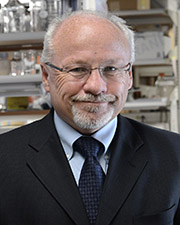Adaptable, at-home COVID testing device developed at KU receives funding boost
LAWRENCE — An at-home COVID-19 testing device developed by a University of Kansas professor is another step closer to hitting the market.
 BioFluidica, a company co-founded by Steven Soper, announced in early February it has received $6 million in Series B2 financing to help bring its LiquidScan instrument to production. Soper — who is a Foundation Distinguished Professor with appointments in the School of Engineering and Department of Chemistry — has spent much of the last two years repurposing “lab on a chip” technology he had previously developed to give doctors simple tools to more easily and quickly diagnose conditions ranging from stroke to different cancers.
BioFluidica, a company co-founded by Steven Soper, announced in early February it has received $6 million in Series B2 financing to help bring its LiquidScan instrument to production. Soper — who is a Foundation Distinguished Professor with appointments in the School of Engineering and Department of Chemistry — has spent much of the last two years repurposing “lab on a chip” technology he had previously developed to give doctors simple tools to more easily and quickly diagnose conditions ranging from stroke to different cancers.
The financing should help BioFluidica fund some of the next steps in the process, including testing and FDA approval, as well as marketing.
“Doing something in the research lab is hard and challenging. Taking it to the next level of a consumer product is daunting,” Soper said of the funding announcement. “All of these things have to be in place, and that’s a major undertaking.”
Production, he said, could begin this summer.
The LiquidScan device will be able to fit in the palm of a user’s hand — it measures about 8 inches long, 3 inches wide and 3 inches deep. At-home users would put saliva on the test chip, then use a hand-held electronic reader to analyze the results. The whole process would take around 15 minutes. Users would be able to buy a test for about $10, and the reader, which can be reused many times over, for about $50.
The emergence of new COVID variants like Delta and Omicron shows that there will be a continued need for such technology, Soper said.
“Testing will never go away. It’s now becoming more important,” he said.
The LiquidScan device should be adaptable, he said.
“It’s easily tuned to accommodate new viruses, and there’s going to be new variants that pop up every year. We’ll be able to take this test and screen for that,” Soper said.
That versatility means the device will also have other uses. Soper said collaborators at KU Medical Center, including cancer researcher Andrew Godwin, are looking to use it to screen patients for the early detection of ovarian cancer, while others hope to use it as a way to quickly diagnose people experiencing ischemic strokes.
“I have a lot of hope for this technology. This never could’ve been realized without several things — including, number one, the resource capabilities at KU,” Soper said, referring to the Ralph N. Adams Nanofabrication Facility at Gray-Little Hall.
KU Medical Center has also been instrumental, providing samples for Soper’s team to use as it fine-tunes the device. “An instrument is no good unless you can test it on real clinical samples,” he said. “This is a great example of teamwork between KU-Lawrence and KUMC.”
Soper earned his doctorate in bioanalytical chemistry from KU in 1989 and returned to the university as a faculty member in 2016. Funding to develop the COVID-19 test comes from the National Institutes of Health RADx Program.